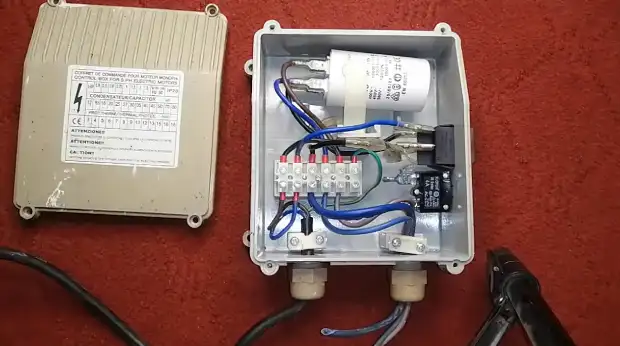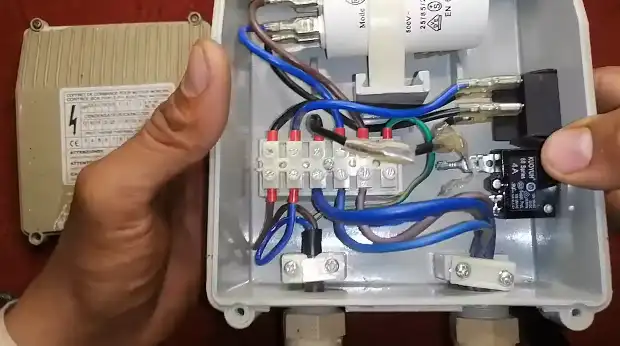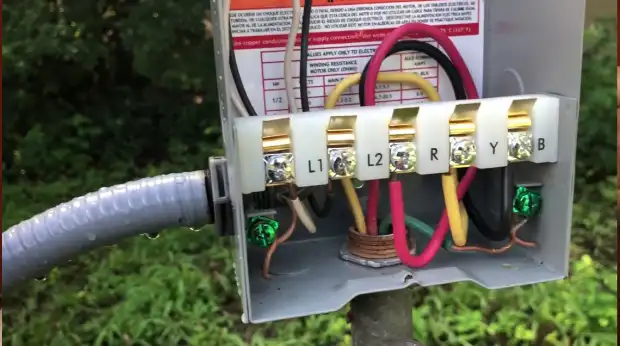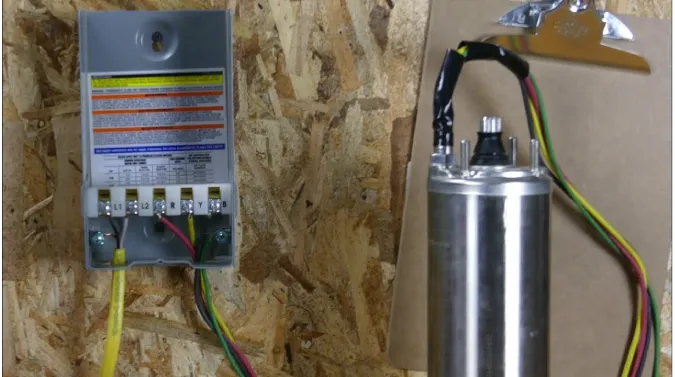Last Updated on October 5, 2023
A well pump controller might be a question on your mind as you consider the operation of your well pump system.
In determining whether you need a well pump controller, the answer is contingent upon your type of well pump.
A control box is unnecessary if you possess an above-ground well pump (commonly known as a jet pump) or a two-wire submersible well pump. These pumps are designed to operate without a control box, as their control mechanisms are integrated into the pump system itself.
But, a control box becomes essential if your well system employs a three-wire submersible well pump. This control box serves as the interface for adjusting settings and controlling the pump’s operation.
We’ll talk about why well pump controllers are necessary and how to identify a failing one.
Why Do You Need a Well Pump Controller?

In well systems, a well-pump controller is considered essential for several reasons. The following are among them:
- Efficiency
- Maintenance
- Protection
- Optimization
- Convenience
1. Efficiency
Installing a well pump controller can significantly improve the efficiency of your pump. This controller monitors the water pressure and activates the pump only when necessary, preventing it from running continuously and consuming unnecessary energy.
By regulating the pump’s operation, the controller ensures that it operates at its optimal capacity, reducing wear and tear on the pump and extending its lifespan.
Also, the controller can adjust the pump’s speed based on the demand, further enhancing its efficiency.
With the use of advanced technology and sensors, the well pump controller can detect any abnormalities in the pump’s performance and alert you, allowing for timely maintenance and preventing costly breakdowns.
Investing in a well pump controller is a wise choice to maximize the efficiency and longevity of your pump system.
2. Maintenance
A well pump controller plays a crucial role in monitoring and providing information about your pump’s activity, making maintenance and troubleshooting much easier.
By proactively monitoring the pump’s performance, you can identify any potential issues early on and take corrective measures. This ensures the smooth operation of your pump and extends its lifespan.
Regular maintenance, such as inspecting and cleaning the pump components, checking the pressure settings, and lubricating moving parts, can be easily facilitated with the help of a well pump controller.
With the ability to monitor and track your pump’s activity, you can stay on top of maintenance tasks and avoid costly repairs in the long run.
3. Protection
To ensure the safety and longevity of your pump motor, it’s important to have a controller that protects against voltage issues and low water levels.
A well pump controller acts as a safeguard, monitoring the electrical voltage supplied to the motor and ensuring it remains within safe operating limits.
With voltage fluctuations being a common occurrence, especially during storms or power surges, having a controller in place can prevent damage to the motor caused by overvoltage or under-voltage situations.
Also, a well pump controller also detects low water levels, which can lead to the motor running dry and burning out. The controller prevents further damage by shutting off the motor when the water level is too low.
With these protective features, a well-pump controller is essential for maintaining your pump motor’s performance and durability.
4. Optimization
Fine-tuning your pump’s settings is essential for optimal performance and water management. With three-wire submersible pumps, having a control box allows you to optimize the pump’s performance.
With the control box, you can adjust various settings to ensure that the pump operates at its best. One important setting to consider is the cut-in and cut-out pressure. By adjusting these settings, you can control when the pump turns on and off, ensuring that it operates efficiently and only when needed.
Additionally, the control box allows you to set the maximum run time for the pump, preventing it from running continuously and potentially causing damage.
5. Convenience
Having a control box makes it easier to operate and adjust the settings of your pump system, providing convenience and ease of use.
With a control box, you can effortlessly monitor and manage your well pump system without the need for manual intervention.
The user interface of modern control boxes is designed to simplify interactions, allowing you to navigate through various settings and options effortlessly.
You can easily adjust the water pressure, set timers for specific operation schedules, and even troubleshoot any issues that may arise.
The control box provides a centralized location for all the essential controls, ensuring that you have quick and convenient access to your pump system’s functionalities.
It eliminates the need for complicated wiring and multiple switches, streamlining the operation and maintenance of your well pump system.
How Do You Know If Your Well Pump Controller Is Bad and What to Check?

If you suspect that your well pump controller is bad, there are a few key points to check.
1. Symptoms
You might notice signs like water pressure fluctuations, strange pump noises, or frequent short cycling if your well pump is not controlled properly. These symptoms can indicate issues with the control system that regulates the operation of your well pump.
Water pressure fluctuations occur when the pump is not receiving the proper signals to maintain a consistent pressure.
Unusual pump noises, such as grinding or clicking sounds, can be attributed to a faulty controller that is not properly controlling the pump motor.
Frequent short cycling, where the pump turns on and off rapidly, is another sign of a malfunctioning controller. You need to address these symptoms promptly to prevent further damage to your well pump system and ensure your water supply’s consistent and efficient operation.
2. Basic Checks
Check the power cord connection and inspect for any blown fuses to ensure there is power to the control box. This is a crucial step in troubleshooting your well pump controller.
Begin by verifying that the power cord is securely plugged into an outlet or power source. If the connection appears loose or damaged, it may need to be replaced.
Next, carefully examine the control box for any blown fuses. A blown fuse can disrupt the power supply to the controller, causing it to malfunction. If you notice a blown fuse, replace it with a new one of the same rating.
3. Multimeter Test
To test the control box’s capacitor terminals, use a multimeter to measure the voltage. This will help you determine if the capacitor is functioning properly or if it needs to be replaced.
Start by setting your multimeter to the voltage measurement mode. Then, carefully connect the multimeter’s probes to the capacitor terminals, correctly matching the positive and negative terminals.
Once the connections are secure, turn on the power to the control box. The multimeter will display the voltage reading, which should be within the specified range for your particular capacitor.
If the reading is significantly lower or higher than the expected value, it is a clear indication that the capacitor is faulty and requires replacement.
4. Bypass Test
If the pump is working properly when connected directly to the power source wires, it may be time to replace the control box.
The bypass test is a simple way to determine if the control box is the culprit behind your well pump issues. To perform this test, you will need to disconnect the pump wires from the control box and connect them directly to the power source wires.
Make sure to follow all necessary safety precautions before attempting this test. Once the connections are made, turn on the power source and observe the pump’s performance.
If the pump operates normally without the control box, it indicates that the control box is likely malfunctioning and needs to be replaced. This test helps pinpoint the problem’s source and ensures an accurate diagnosis.
How long does a well pump controller last?

The lifespan of a well pump controller can vary based on factors such as quality, usage, and environmental conditions. Generally, well pump controllers are designed to last a significant period, ranging from 5 to 15 years or more.
High-quality controllers that are well-maintained and protected from harsh conditions tend to last longer. Regular maintenance, including proper wiring, protection from water exposure, and periodic inspections, can contribute to extending the lifespan of a well pump controller.
However, factors like power surges, voltage fluctuations, and environmental wear and tear can influence the durability of the controller over time.
If you notice any signs of malfunction or degradation in performance, it’s advisable to address the issue promptly to ensure the continued efficiency of your well water system.
Are well pump control boxes interchangeable?
Well pump control boxes are not universally interchangeable, as their compatibility depends on factors such as motor horsepower (HP) and capacitor size. The control box’s HP rating should match that of the motor for optimal performance and safety.
However, for testing purposes, a larger control box, such as a 1.5HP box, can temporarily work with smaller pumps like 1/2, 3/4, 1, or 1.5HP motors.
It’s important to note that using a larger control box for smaller pumps is not recommended for permanent installation due to the potential risks associated with oversized capacitors.
Utilize the Power of Well Pump Controllers for Uninterrupted Water Supply
It is now clear that which type of well pump needs a controller depends on the specific characteristics of your pump system.
While above-ground and two-wire submersible pumps operate smoothly without a control box, a three-wire submersible pump requires this essential component for optimal performance, protection, and ease of use.
From enhancing efficiency and facilitating maintenance to safeguarding your pump motor and streamlining operation, a well pump controller offers a range of benefits.
Understanding the compatibility factors and conducting proper tests can help promptly identify and address controller issues.


